Are you looking to elevate your forex trading game? Look no further than the forex gap trading strategy. This powerful technique capitalizes on price gaps that occur in the foreign exchange market, offering traders unique opportunities to profit. In this comprehensive guide, we’ll delve deep into the world of forex gap trading, exploring its intricacies, benefits, and how you can implement it in your trading arsenal. To enhance your trading experience and access optimal gap trading conditions, partnering with a reputable forex trading broker is essential for providing the right tools and insights.

Forex gap trading strategy is a method that focuses on identifying and exploiting price gaps in currency pairs. These gaps occur when the opening price of a currency pair differs significantly from its previous closing price, creating a “gap” on the price chart. By understanding and leveraging these gaps, traders can potentially earn substantial profits.
Let’s embark on this journey to master the art of forex gap trading and unlock new possibilities in your trading career.
Gap Trading Basics
Before diving into advanced strategies, it’s crucial to understand the fundamentals of gap trading in the forex market. This knowledge will form the cornerstone of your gap trading strategy and help you make more informed decisions.
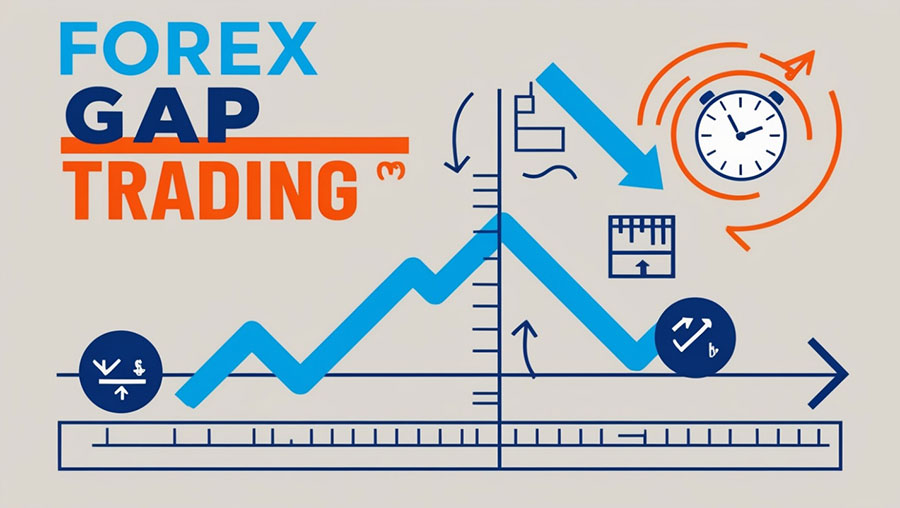
What Causes Gaps in Forex?
Gaps in the forex market occur due to several factors:
- Economic Data Releases: Surprise economic reports can cause significant price movements, especially when released during off-market hours.
- Geopolitical Events: Political developments, elections, or conflicts can dramatically shift market sentiment, leading to gaps.
- Central Bank Decisions: Unexpected interest rate changes or policy shifts can create substantial gaps.
- Natural Disasters: Major environmental events can impact currency values, particularly for the affected countries.
- Market Sentiment Shifts: Sudden changes in investor sentiment, often triggered by global events, can cause gaps.
The Mechanics of Gap Formation
Gaps form when there’s a significant imbalance between buy and sell orders at market open. This imbalance can be due to:
- Accumulation of Orders: During market closure, orders accumulate based on new information, leading to a price jump at open.
- Liquidity Differences: Lower liquidity during off-hours can exaggerate price movements, resulting in gaps.
- Algorithmic Trading: High-frequency trading algorithms can react instantly to news, creating gaps.
Gap Characteristics
Understanding gap characteristics is crucial for effective trading:
- Size: Measured in pips, larger gaps often indicate more significant market events.
- Direction: Gaps can be bullish (upward) or bearish (downward), reflecting market sentiment.
- Duration: Some gaps fill quickly, while others may persist for extended periods.
- Frequency: Certain currency pairs are more prone to gaps than others.
The Concept of ‘Filling the Gap’
Many traders focus on the tendency for gaps to ‘fill’:
- Definition: A gap is considered ‘filled’ when the price returns to the pre-gap level.
- Probability: While many gaps fill, it’s not guaranteed. Some gaps may never fill completely.
- Timeframe: Gap filling can occur within hours, days, or even weeks.
- Trading Implications: The gap-fill tendency forms the basis for many trading strategies.
Basic Gap Trading Approaches
There are two primary approaches to gap trading:
- Fade the Gap:
- Concept: Trade against the direction of the gap, anticipating a reversal.
- Strategy: Enter a trade in the opposite direction of the gap, aiming for the gap to fill.
- Risk: Higher risk, as you’re trading against the initial market momentum.
- Trade the Gap Continuation:
- Concept: Trade in the direction of the gap, expecting the trend to continue.
- Strategy: Enter a trade in the same direction as the gap, anticipating further movement.
- Opportunity: Can lead to significant profits if a new trend is forming.
Key Considerations for Gap Trading
- Volatility: Gaps often lead to increased volatility, requiring careful risk management.
- News Awareness: Stay informed about potential market-moving events.
- Multiple Timeframes: Analyze gaps on various timeframes for a comprehensive view.
- Patience: Not every gap presents a tradable opportunity. Wait for confirming signals.
- Practice: Use demo accounts to practice gap trading strategies before risking real capital.
Understanding these gap trading basics provides a solid foundation for developing more advanced strategies. As you progress, you’ll learn to combine these fundamentals with technical analysis, risk management techniques, and market psychology to create a robust gap trading approach tailored to your trading style and goals.
Read More: 1 minute forex trading strategy
Understanding Forex Gaps
What Are Forex Gaps?
Forex gaps are price discontinuities that appear on currency pair charts when the opening price of a new trading session differs from the closing price of the previous session. These gaps can occur due to various factors, including:
- Weekend gaps: Most common in forex, occurring between Friday’s close and Sunday’s open
- Holiday gaps: When markets close for national holidays
- News-driven gaps: Resulting from significant economic or political events
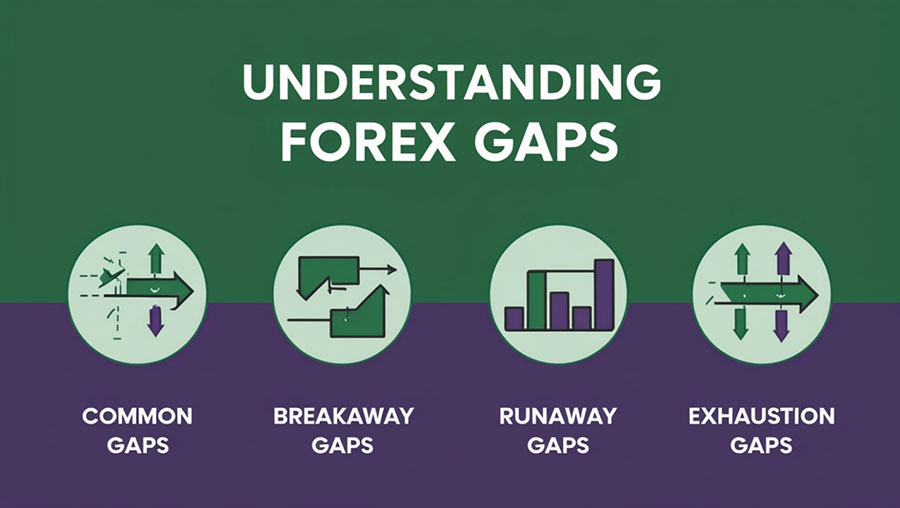
Types of Forex Gaps
To effectively implement a forex gap trading strategy, it’s crucial to understand the different types of gaps:
- Common gaps: Occur frequently and are usually filled quickly
- Breakaway gaps: Signal the start of a new trend
- Runaway gaps: Appear in the middle of a strong trend
- Exhaustion gaps: Indicate the potential end of a trend
The Psychology Behind Gaps
Gaps in forex markets often reflect sudden shifts in market sentiment or reactions to unexpected events. Understanding the psychology behind these gaps can give traders a significant edge in predicting market movements and making informed decisions.
Implementing a Forex Gap Trading Strategy
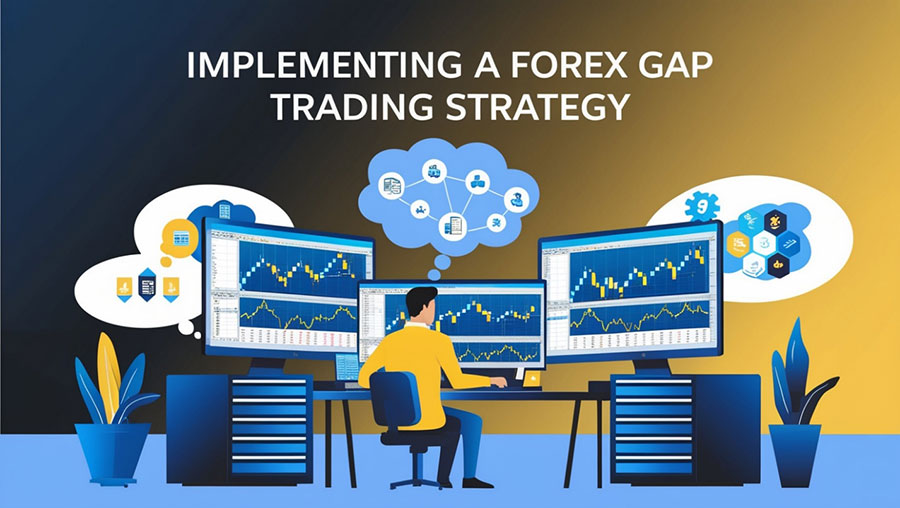
Step 1: Identifying Gaps
The first step in executing a successful forex gap trading strategy is to identify gaps accurately. Use these techniques:
- Visual chart analysis: Look for clear price discontinuities on your charts
- Price comparison: Compare the opening price of a new session with the previous session’s closing price
- Gap scanning tools: Utilize specialized software to detect gaps automatically
Step 2: Analyzing Gap Characteristics
Once you’ve identified a gap, assess its characteristics to determine its potential:
- Gap size: Larger gaps may indicate stronger market sentiment
- Volume: Higher volume often suggests more significant gaps
- Market context: Consider overall market trends and conditions
Step 3: Developing Trading Rules
Create a set of rules for your forex gap trading strategy:
- Entry criteria: Define when to enter a trade based on gap type and size
- Stop-loss placement: Set appropriate stop-loss levels to manage risk
- Take-profit targets: Determine realistic profit objectives
- Risk management: Limit your exposure per trade and overall account risk
Step 4: Executing Trades
With your rules in place, execute your trades confidently:
- Wait for confirmation: Look for additional signals to support your gap trade
- Use limit orders: Place orders at predetermined levels to catch gap fills
- Monitor price action: Stay vigilant for potential reversals or continuations
Step 5: Managing and Adjusting Trades
Actively manage your gap trades:
- Trail stops: Move your stop-loss to protect profits as the trade progresses
- Partial profit-taking: Consider closing a portion of your position at key levels
- Re-evaluation: Continuously assess market conditions and adjust your strategy accordingly
Read More: 1-hour forex trading strategy
Advanced Forex Gap Trading Techniques
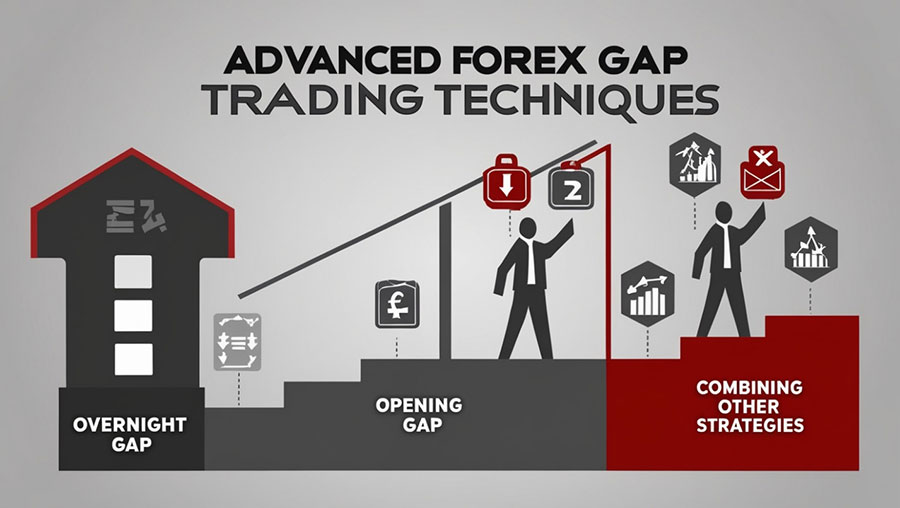
Overnight Gap Trading Strategy
The overnight gap trading strategy focuses on gaps that occur between market closes and the following day’s open. To implement this strategy:
- Identify currency pairs prone to overnight gaps
- Analyze pre-market news and events
- Set alerts for significant price movements
- Place pending orders to capitalize on potential gaps
- Manage risk with appropriate stop-loss and take-profit levels
Opening Gap Trading Strategies
Opening gap trading strategies aim to profit from gaps that occur at market open. Consider these approaches:
- Fade the gap: Trade against the gap direction, anticipating a reversal
- Ride the gap: Enter trades in the direction of the gap, expecting continuation
- Wait for confirmation: Allow the market to settle before entering a trade
- Use multiple timeframes: Analyze gaps on various timeframes for a comprehensive view
Combining Gap Trading with Other Strategies
Enhance your forex gap trading strategy by integrating it with other proven techniques:
- Support and resistance: Use key levels to identify potential gap fill targets
- Trend analysis: Align gap trades with overall market trends
- Candlestick patterns: Look for confirming patterns near gap areas
- Fibonacci retracements: Use Fibonacci levels to set entry and exit points
Risk Management in Forex Gap Trading
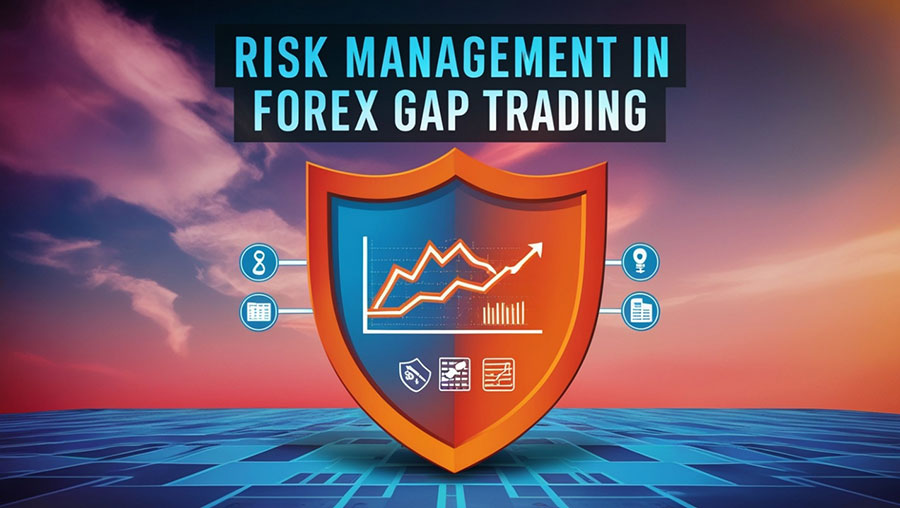
Effective risk management is crucial for long-term success in forex gap trading:
- Position sizing: Limit your risk per trade to a small percentage of your account
- Diversification: Trade multiple currency pairs to spread risk
- Use of stop-loss orders: Always have a predetermined exit point for losing trades
- Risk-reward ratio: Aim for a favorable risk-reward ratio on each trade
- Emotional control: Stick to your trading plan and avoid impulsive decisions
Tools and Resources for Forex Gap Trading
Equip yourself with the right tools to excel in forex gap trading:
- Advanced charting software: Use platforms with gap detection and analysis features
- Economic calendars: Stay informed about potential market-moving events
- News feeds: Access real-time news to anticipate potential gaps
- Backtesting software: Test your gap trading strategies on historical data
- Trading journals: Track your trades and analyze your performance
Common Pitfalls in Forex Gap Trading
Avoid these common mistakes to improve your forex gap trading results:
- Overtrading: Don’t force trades when high-quality gaps are scarce
- Ignoring market context: Consider broader market conditions when trading gaps
- Neglecting risk management: Always prioritize capital preservation
- Chasing gaps: Avoid entering trades late or without proper confirmation
- Emotional trading: Stick to your strategy and avoid making decisions based on fear or greed
Measuring Success in Forex Gap Trading
Track your progress and refine your forex gap trading strategy:
- Keep detailed trade logs: Record all your gap trades and their outcomes
- Calculate key metrics: Monitor win rate, average profit/loss, and risk-reward ratio
- Regular performance reviews: Analyze your trading results periodically
- Continuous learning: Stay updated on market trends and new gap trading techniques
- Seek feedback: Engage with other traders and mentors to improve your skills
Read More: 5-Minute Trading Strategy
OpoFinance Services: Your Partner in Forex Trading Success
As you embark on your forex gap trading journey, consider partnering with OpoFinance for unparalleled trading support. OpoFinance offers a comprehensive suite of services tailored to both novice and experienced traders:
- Advanced trading platforms: Access cutting-edge technology for seamless gap trading execution
- Educational resources: Enhance your knowledge with expert-led webinars and tutorials
- Professional analysis: Benefit from in-depth market insights and gap trading opportunities
- Competitive spreads: Maximize your profits with tight spreads on major currency pairs
- Dedicated customer support: Receive personalized assistance from knowledgeable professionals
With OpoFinance by your side, you’ll have the tools and support needed to excel in forex gap trading and achieve your financial goals.
Conclusion
Mastering the forex gap trading strategy can significantly enhance your trading performance and open up new avenues for profit. By understanding the dynamics of gaps, implementing a robust trading plan, and continuously refining your approach, you can capitalize on these unique market opportunities.
Remember, successful forex gap trading requires patience, discipline, and a commitment to ongoing learning. Stay informed about market events, practice proper risk management, and always be prepared to adapt your strategy as market conditions evolve.
As you continue to develop your forex gap trading skills, consider leveraging the resources and support offered by reputable brokers like OpoFinance. With the right tools and knowledge at your disposal, you’ll be well-equipped to navigate the exciting world of forex gap trading and potentially achieve remarkable trading success.
How do I handle false breakouts when using a forex gap trading strategy?
False breakouts can be challenging when implementing a forex gap trading strategy. To handle them effectively:
Wait for confirmation: Don’t rush into trades immediately after a gap forms. Look for additional signals, such as candlestick patterns or volume confirmation, before entering a position.
Use wider stop-losses: Place your stop-loss orders at a safe distance to account for potential volatility and avoid getting stopped out prematurely.
Implement a time-based filter: Wait for a certain period (e.g., 15-30 minutes) after the market opens to allow for initial price discovery and reduce the risk of false breakouts.
Consider partial entries: Enter your position in stages to minimize the impact of false breakouts on your overall trade.
Are there specific currency pairs that are more prone to gaps in the forex market?
Yes, certain currency pairs are more susceptible to gaps than others:
Exotic pairs: Currency pairs involving less liquid currencies often experience more frequent and larger gaps due to lower trading volumes.
Pairs affected by specific economic releases: For example, the AUD/USD may gap more frequently around Australian economic announcements.
Pairs with non-overlapping trading hours: When there’s a significant time difference between the main trading sessions of the currencies involved, gaps are more likely to occur.
Commodity-linked currencies: Pairs involving currencies heavily influenced by commodity prices (e.g., CAD, AUD, NZD) may gap more often due to fluctuations in commodity markets.
How can I incorporate fundamental analysis into my forex gap trading strategy?
Integrating fundamental analysis into your forex gap trading strategy can enhance your decision-making process:
Monitor economic calendars: Stay informed about upcoming high-impact economic events that could potentially create gaps.
Analyze central bank policies: Understanding monetary policy decisions can help you anticipate potential gaps and market reactions.
Follow geopolitical events: Keep track of major political developments that could impact currency valuations and create gaps.
Assess long-term economic trends: Consider how broader economic factors might influence currency pairs and their susceptibility to gaps.
Use sentiment indicators: Incorporate market sentiment data to gauge potential gap directions and magnitudes.
By combining technical analysis of gaps with fundamental insights, you can develop a more comprehensive and robust forex gap trading strategy.







